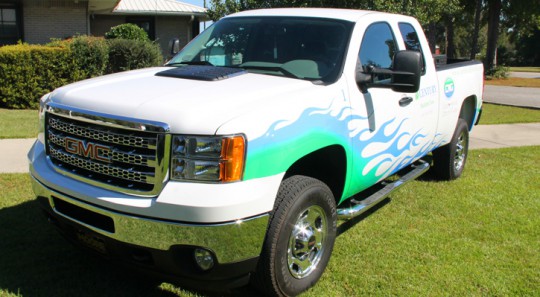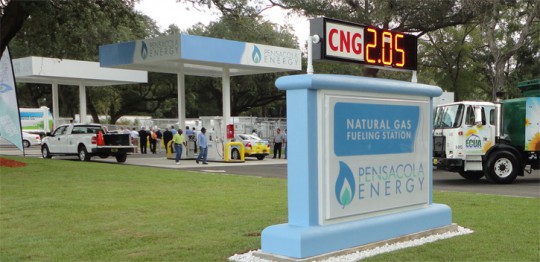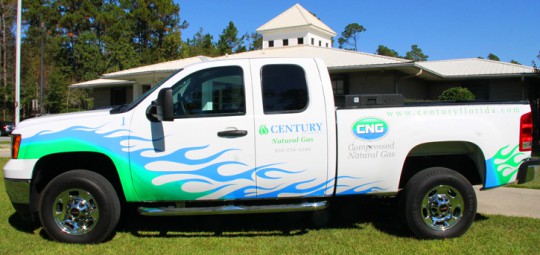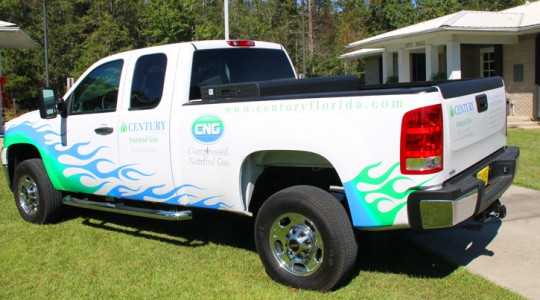Century Joins Other Local Governments In Natural Gas Vehicle Push
October 28, 2013
The Town of Century has purchased their first natural gas powered truck, and the town’s first filling station will be installed soon. Meanwhile, other local governments are jumping on the natural gas powered vehicle bandwagon in a big way.
 “Natural gas is going to be the future,” Century Mayor Freddie McCall said. “We are trying to get in on the ground floor of it.”
“Natural gas is going to be the future,” Century Mayor Freddie McCall said. “We are trying to get in on the ground floor of it.”
The duel-fuel GMC pickup switches seamlessly between compressed natural gas and unleaded gasoline. The only big difference is the price…a gallon of regular unleaded gas is about $3.25, while the town’s cost as a supplier for an equivalent gallon of natural gas is $1 or less.
“The savings will really add up over time,” McCall said, “with natural gas prices down like they are.”
The City of Pensacola, Escambia County and the Emerald Coast Utilities Authority are also jumping onto the natural gas bandwagon in a partnership. According to Mayor Ashton Hayward, Pensacola has been able “to transfer over 100 vehicles from diesel to compressed natural gas, a fuel that is cheaper, cleaner, and most importantly, produced right here in America”.
 As ECUA transitioned vehicles to natural gas, they projected an annual maintenance cost savings in excess of $350,000 and an annual fuel cost savings about $900,000.
As ECUA transitioned vehicles to natural gas, they projected an annual maintenance cost savings in excess of $350,000 and an annual fuel cost savings about $900,000.
Pensacola has already constructed two CNG fueling stations with a third slated for completion in December.
“We’ll eventually open up to corporate fleets and private vehicles. This gives us a competitive edge in recruiting business and bringing more jobs,” Hayward said.
McCall sees the same opportunities for Century. The first filling station won’t be open to the public, but Century’s mayor hopes to construct a public CNG filling station soon. He’s already spreading the good news of low priced CNG to area trucking companies and other industries. And the town is looking forward to purchasing additional CNG vehicles in the future.
Century’s first CNG truck serves as a rolling billboard as well as work vehicle. The truck, on a state contract price purchase, was $34,999 from Pete Moore Chevrolet in Pensacola. The cost included $9,300 to convert the vehicle to natural gas. A Natural Gas Fuel Fleet Vehicle Rebate program through the Florida Department of Agriculture and Consumer Services is valued at half of the cost of the conversion ($4,650). The cost of the ad wrap from Pensacola Sign and Graphics was $1,728.
The gas department will “sell” one of their existing trucks to the Century Water Department for $12,900, which was already in the water department’s budget for a truck.
In addition, Century’s first filling station equipment and a shed will cost about $30,000 to be funded with LOST – local option sales tax – monies. The equipment will be installed in about six weeks.
Pictured top and bottom: Century’s new pickup powered by compressed natural gas. Pictured bottom inset: Pensacola Energy’s CNG filling station on Pine Forest Road just south of Nine Mile Road. NorthEscambia.com photos, click to enlarge.
Comments
14 Responses to “Century Joins Other Local Governments In Natural Gas Vehicle Push”





David,
Yes, I believe that is the explanation I was given several months ago about why the wear on the brakes is so dimished. Thank you for contributing that.
CNG User,
Yes, there is less power with the CNG– however, that is why it is so well suited to our fleet of sanitation trucks. They do not need to get up to very high speeds between pick-ups from house to house, especially in the more densely populated portions of our service area, where the distances between homes are so small.
Cost will definitely reduce to half or even less. e.g. if you cover a distance in 6 bucks on Diesel then you’ll cover same distance in 3 bucks on CNG.
But CNG will not provide as much power as Diesel or Petrol, but still its cheap and environment friendly.
Nathalie,
Most likely the brake life improvement is tied to the system which captures energy of motion while stopping and uses it when starting to move again. That would reduce brake wear because the brakes wouldn’t be doing as much work as well as improve fuel economy because kinetic energy would be conserved.
Just a guess, though.
David for useful energy conservation
Mr. Jeeperman,
Our results indicate average mpg of 1.8mpg on diesel; 3.3 mpg with CNG. I’ll be glad to get more info on that from our fleet manager if you’d like.
Thank you, David Huie Green, for the more detailed explanation of the gallon equivalent. Yes, you are correct.
For I Drive One,
The trucks were not retrofitted diesel vehicles. They are original CNG. I will have to get more details on the brake systems that our CNG vehicles have from our fleet manager. That might take a day or so as I am not in the office today. I will send the info to William and perhaps he can forward that to you if you wish.
The mileage for gas or CNG is nearly identical on a Ford F150. While gas prices are coming down slightly the price we pay for CNG has not. Still at $1.96(much more than centurys $1.00)a gallon it provides quite a savings.
But a question for Ms. Bowers,
How does fuel type help save the brakes on what was a diesel vehicle?
c. w.,
They are saying gallon-equivalent, not gallon. The energy released by burning one gallon of gasoline or diesel is the amount of energy released by burning the gallon-equivalent amount of natural gas. Since they both heat the compressed air-fuel mixture in the engine, the power output should be comparable, fuel economy comparable but natural gas combustion more complete.
David for better methane use
Nathalie Bowers,
Please review your mpg numbers again. If your fleet mileage is about double that of diesel fuel, or better your some how breaking the rules of physics.
The universal formula is that you will get about 90% of the MPG you got on diesel.
i.e if the trucks were getting 5mpg on diesel, they will get 4.5mpg on CNG.
There is no way around it.
Of course if the old trucks had 12 liter diesels and the cng trucks have 4 liter engines…………………..
@c.w. – your question is well put. But, don’t think you’ll find an objective truthful comparison anywhere. The only data I have found on the web is sponsored by natural gas companies, and that data is, of course, suspicious. We’ll have to rely on real life experience from users to see what the mileage truly is. Remember how we were (and still are) told how great Ethanol is, but we also know that mileage suffers, it attracts and holds water (ever see the mildew around gas caps on light color cars?), and dissolves rubber components. CNG won’t do those things, but it is a high pressure fuel, and we’ve all seen what gas leaks can do. This will be interesting to say the least.
Response to c.w.:
The mileage is about double that of diesel fuel, or better. Since July 2012, we have seen savings not only in the price per gallon and in mileage efficiency, but also in the operating costs and maintenance– we’ve seen considerably less wear on the brakes and have eliminated the need for diesel particulate filters (DPF) the the vehicles’ exhaust systems. We estimate a saving of $16,000 per vehicle considering the changes with the brakes and DP filters. We have 50 trucks in our Sanitation fleet, and 72 vehicles in all now have CNG capability. We expect that over the life of the vehicles, each will save about $56,000.
for Shiloh:
CNG is particularly well suited to a fleet such as ours because the vehicles are refueled at night (we have 90 slow-fill bays at the Pine Forest station) and the tanks are sized appropriately for the mileage each covers daily. I think a lot has changed in the CNG industry in the last few years.
Congratulations to Mayor McCall and the entire Century Town Council for making the decision to go to natural gas. Maybe soon all the city vehicles will be running on natural gas. A dollar saved is a dollar earned is what my Dad taught me. In order to give our future generations a cleaner environment we all need to go “Greener”. I look forward to the day when all New vehicles come with the equipment to run Natural gas.
Milton tried the NG thing several years ago. The police cars had to stop and fill their tanks two or three time a 8 hour shift. The city put a NG service station in that is almost unused. Maybe NG autos have improved over the years, but??????.
>>>Please explain the reasoning for spending our taxdollars on a blinged out municipal work truck.
The story says “Century’s first CNG truck serves as a rolling billboard as well as work vehicle.” Not necessarily all your tax dollars…the gas dept makes a small profit to sustain itself.
Please explain the reasoning for spending our taxdollars on a blinged out municipal work truck.
Four-Wheel drive that likely will not see a dirt road let alone any mud.
Full chrome package.
3/4 ton that will never be used to haul anything over 1000 lbs nor ever pull a trailer.
Does it have a snow plow too?
I see a lot about what a gallon of NG cost, but how many gallons will it take to get as many miles as a gallon of gasoline? In other words, what’s the gas mileage?